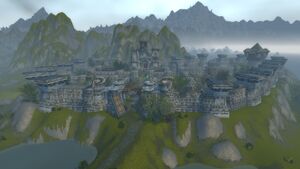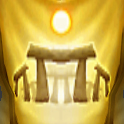Arathor
- This article is about the ancient human empire. For the modern half-elf Arathi empire, see Arathi Empire. For other uses, see Arathi (disambiguation).
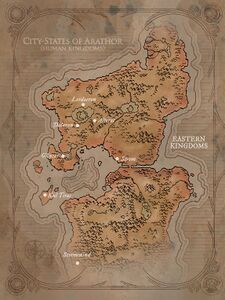 The city-states of Arathor at the time of its disintegration in 1,200 BDP. | |
| Main leader |
|
| Race(s) |
|
| Capital | Strom |
| Other major settlements | Alterac Fortress, Boralus, Dalaran, Gilneas, Lordaeron, Stormwind |
| Theater of operations | Lordaeron, Kul Tiras, Khaz Modan |
| Government | Empire / Kingdom |
| Sub-group(s) | Arathi tribe, Alteraci tribe, Lordain's tribe, and others |
| Affiliation | Independent |
| Status | Defunct |
Arathor (variously called the the Empire of Arathor,[1][2] the Arathorian Empire,[3][4][5][6] or the Arathi Empire)[7] was the first great human civilization,[5][8][9] which ruled over much of the northern Eastern Kingdoms between its founding circa 2,800 BDP and its disintegration circa 1,200 BDP.[10][11][12][13] Its capital was the city of Strom (now Stromgarde) in the Arathi Highlands.
The empire was established through the unification of the warring human tribes under the Arathi tribe and their king, Thoradin, in response to increased aggression from the Amani forest trolls. During the Troll Wars, Arathor allied with the high elves of Quel'Thalas and helped them defeat the Amani Empire, with the high elves teaching the humans arcane magic in exchange for their military aid. In the centuries that followed, Arathor expanded across large portions of the northern Eastern Kingdoms through the founding of multiple city-states. These city-states grew increasingly autonomous over time, until eventually the Empire of Arathor split apart into the Seven Kingdoms of the modern day: Stromgarde, Dalaran, Gilneas, Alterac, Kul Tiras, Lordaeron, and Stormwind.
History
Founding (2,800 BDP)
- See also: Early humans, Arathi tribe, Thoradin
For millennia, the nomadic hunter-gatherer human tribes flourished in the Eastern Kingdoms. They constantly warred with one another for land and power, even as they were being raided by their northern neighbors, the forest trolls of the Amani Empire. Circa 2,800 BDP, increased aggression from the trolls caused the Arathi tribe and their warlord, Thoradin, to realize that the trolls were becoming too great a threat to ignore and that humanity would stand little chance in a true war against the Amani if they remained divided.[12][14][15]
Thoradin declared himself the first king of the humans[16][17] and embarked on a six years-long campaign to unite the tribes under a single banner through political marriages, promises of wealth and land, or conquest. After each victory, Thoradin offered the conquered people peace and equality in what he claimed would be a glorious new human kingdom of unlimited potential. The tribal leaders would not fade into obscurity but instead become his honored generals. In this way, the Arathi won the loyalty of their adversaries.[12][14][15] This strategy was a new one among humans, a testament to both the youth of their race and their willingness to gain strength through clear-sighted pragmatism.[18]
The Arathi tribe eventually came to include many disparate tribes. With humanity united, Thoradin named his new kingdom "Arathor" and founded a capital, the fortress-city of Strom, in the region now called the Arathi Highlands. He also ordered the construction of Thoradin's Wall near the capital to shield humanity from Amani incursions. Word of Strom quickly spread among human tribes across the continent, and many traveled to the city for safety. Confident that they could defend themselves against both the trolls and the reclusive high elves if need be, the people of Arathor developed a strong, optimistic culture.[12][14][15]
Troll Wars (2,800 BDP)
- Main article: Troll Wars
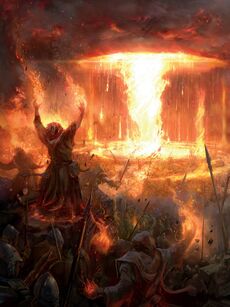
Amani trolls soon began encroaching on the outlying human territories. Thoradin sent the Arathi military, including his foremost generals Ignaeus and Lordain, to patrol Arathor's borders and prevent the trolls from straying too deep into the empire.[12][15]
At this time, the Troll Wars began when the Amani, with guidance from the Zandalar tribe, attacked the high elf kingdom of Quel'Thalas. The outnumbered elves quickly lost ground.[18][19][20][21] Over the course of months, rumors of the conflict trickled down to Arathor, but Thoradin and his generals agreed that they would not risk their own kind by sending aid to the reclusive elves and instead kept most of their forces in Strom.[12][14] High elf scouts had noticed the rise of Arathor in the south, and in desperation, the high elven king, Anasterian Sunstrider, sent ambassadors to Strom to ask for the humans' aid. Although the humans had no spellcasters, Arathor had a sizeable population and Anasterian hoped that there were humans with magical talent who could become useful in combat if given training.[18]
The high elven ambassadors convinced Thoradin that the Amani armies would move to attack Arathor once they had destroyed Quel'Thalas. Following negotiations between Thoradin and Anasterian, the elves agreed to teach one hundred humans the ways of arcane magic in exchange for Arathor's military aid.[14][18][19][22] While the human magi trained, Thoradin sent his generals to establish a stronghold, Alterac Fortress, at the base of the Alterac Mountains, along with other crude forts in the Eastweald further north.[22] Once the One Hundred had finished their training, Arathor went on the offensive. Thoradin's armies engaged the Amani in southern Quel'Thalas before retreating to Alterac Fortress with the trolls in pursuit, thereby drawing the trolls into a trap. After a days-long siege, the human and elven magi combined their powers to create a firestorm that destroyed most of the Amani army. The surviving trolls fled and were easily defeated by the humans and elves, ending the war.[14][15][22]
The Troll Wars marked the beginning of a prosperous new era for Arathor and Quel'Thalas.[22] The grateful high elves made a pledge of undying loyalty and friendship to Arathor and to Thoradin's bloodline, and the two races would foster peaceful relations for the next two thousand years.[14][18][19][22] Thoradin made a military pact with the elves so that each side would help the other if the Amani ever again became a threat, and also created new territorial borders and trade agreements to foster Arathor's prosperity for generations to come.[15]
Expansion (2,700 BDP - 1,200 BDP)
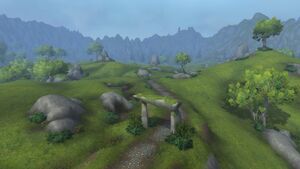
After the Troll Wars, Arathor grew and prospered. However, King Thoradin feared that the kingdom would splinter apart if it overextended itself and maintained that Strom was the center of the empire.[23] He eventually abdicated his throne and disappeared while on a personal quest to find the origins of humanity.[15][24] After his reign, Arathor's younger generations were left free to grow the empire beyond the lands of Strom, beginning a period of expansion circa 2,700 BDP. The original One Hundred taught pupils in the ways of the arcane, dramatically increasing the number of spellcasters in Arathor over the course of a few decades. The protection provided by these magi made it possible for enterprising humans to expand into the wilderness and create new settlements.[23][25] However, as their powers grew, the magicians grew increasingly conceited and isolated from the rest of society.[23] They were increasingly viewed with suspicion and prejudice by the superstitious population, igniting tensions that eventually led most magic users to withdraw from cities and towns.[25]
Also after the Troll Wars, a number of human priests, of whom the first was Mereldar, began receiving visions and dreams of the Holy Light from the naaru in the Great Dark Beyond. Through this connection, the priests learned to use holy magic to heal wounds and illnesses, and they founded a religious movement based on altruism and a belief that the Light dwelled in all things. The movement grew popular among the common folk and became the predominant human religion.[13][26]
Some Arathi settlers claimed former Amani territories in the Eastweald, while others migrated to Alterac Fortress and the smaller forts created during the Troll Wars and turned them into trading outposts. The most coveted lands were located in the fertile Tirisfal Glades, where the Arathi built a stronghold to protect their farmers from wildlife. The region was renamed "Lordaeron" in honor of General Lordain, who had sacrificed himself to ensure the human victory in the Troll Wars. The ruling powers in Strom worried that the new settlements would grow too independent, but despite their efforts, many cities did gain more autonomy over the decades.[25]

The first new Arathi city-state to be built, and the first to gain more independence, was Dalaran, a trading outpost in the center of Arathor which quickly grew in influence and attracted immigrants from across the empire. Under the rule of a mage named Ardogan, Dalaran became an autonomous city-state and a safe haven for Arathor's magi. Ardogan and the sorcerers formed a magocracy to govern Dalaran and turned the city into a center of arcane learning. However, while the magi's protection allowed Dalaran's economy to flourish, the reckless use of the arcane also attracted the attention of scattered demons of the Burning Legion, who began to infiltrate the city from the Twisting Nether. In 2,680 BDP, the magocracy and the high elven Convocation of Silvermoon formed the Council of Tirisfal, a secret order of magi who would track down and banish the demons whenever they appeared.[23][25] In 2,610 BDP,[25] the Council was nearly defeated by the dreadlord Kathra'natir, who tried to spread disease and paranoia across all of Arathor in the hopes of inciting war between the humans, high elves, and gnomes.[n 1] However, Kathra'natir was foiled and banished by Alodi, the first Guardian of Tirisfal.[27] Over the generations that followed, a line of Guardians of Tirisfal continued working in secret to defend the masses of humanity from demonic activity, allowing Arathor to continue to grow and prosper and magic to continue to proliferate through the empire.[23][25]
After Dalaran, many new city-states continued to arise across the continent.[28] Some Arathi created a series of harbors in the peninsular region of Gilneas, from which they engaged in trade with the rest of Arathor. The boldest Gilnean sailors,[25] guided by the first Tidesages who heard the voice of the Tidemother,[29] discovered and settled the island of Kul Tiras in the Great Sea. After fighting a war against the island's native Drust,[30] they established a maritime outpost also named Kul Tiras,[25] centered on the town of Boralus,[31] which developed a prosperous economy based on fishing and shipping. Also during this period,[28] the city-state of Alterac was founded in the Alterac Mountains and came to control much of the northlands.[13] At some point, Arathor also built the citadel of Tol Barad on an island west of Gilneas.[32]
At an unknown point in time, one group of Light-worshipping Arathi left the empire and created their own kingdom "across the sea". Another group in turn splintered from that kingdom after receiving a vision of a falling star that led them to Hallowfall, a subterranean realm in Khaz Algar,[33] through as of yet mysterious circumstances. There the Arathi have remained trapped[6] ever since, developing their own culture distinct from the humans of the Eastern Kingdoms.[33]
Fracturing (1,200 BDP)
- See also: Seven Kingdoms
In 1,200 BDP, Arathor began to split apart, as Strom gradually lost its influence over the other city-states. Dalaran remained the center of learning for magi throughout the land and formed the Kirin Tor, a sect that would research all of the spells and magic items known to mankind at the time. Kul Tiras continued its trading and shipping; its massive navy—the largest in Arathor—explored the remote coasts of the Eastern Kingdoms in search of exotic goods. Unable to compete with Kul Tiras' maritime power, Gilneas focused on improving its mercantile and military capabilities. The Gilnean military became one of the strongest in Arathor, equaled only by Alterac. The two city-states, both strong supporters of Strom, often combined their forces and sent expeditions to explore the southlands. In Khaz Modan, the expeditionary forces made first contact with the dwarves and visited the cities of Ironforge and Gnomeregan. The humans became quick friends with the dwarves and gnomes, and the three cultures exchanged knowledge of smithing, engineering, and the arcane through rigorous trade.[13][28][n 1]
Bound by the mountainous terrain of the Arathi Highlands and lacking natural resources, Strom could not compete with the economies of the other city-states and steadily declined in power. Eventually, many of the city's noble families moved their estates north to the more fertile lands in Lordaeron, where they founded a city-state of the same name and bought up land that had been developed by earlier settlers. Lordaeron was also home to Light-worshipping ascetics, and many people made pilgrimages to the city-state's religious communes in search of healing or enlightenment. Lordaeron's borders quickly expanded into those of a proper kingdom, and the nobles renamed the capital of their nation Capital City.[13][28]
Shortly after the lords of Strom went north, the last descendants of the Arathi bloodline, led by a member of Thoradin's line named Faldir, also abandoned Arathor and sailed south in search of a new beginning. They settled on a continent they named Azeroth and established the kingdom of Stormwind, which quickly became a self-sufficient power. Strom was left in the hands of a few ruling families, notably the Trollbane family, who rebuilt the capital's crumbling infrastructure and renamed it Stromgarde.[13][28]
Over generations, each city-state continued developing its own customs, and rivalries emerged as they grew increasingly insular and concerned only with their own well-being. Though each of the Seven Kingdoms became prosperous in its own right, the Empire of Arathor had effectively disintegrated, and King Thoradin's dream of a unified humanity faded at last.[13][28]
Legacy
The nations of Arathor were not united under a common banner again until over a millennium later, when in 5 ADP[35] Anduin Lothar, the last descendant of Thoradin and the Arathi bloodline, convinced the rulers of the Seven Kingdoms to form the Alliance of Lordaeron and unite against the Orcish Horde.[4][36] Lothar also reminded the high elves of Quel'Thalas of the oath they had sworn his ancestor in order to secure their aid against the Horde in the Second War.[36][37][18][19][38]
After the fall of the kingdom of Stromgarde, its remnants[39] are organized into a faction called the League of Arathor. The League uses a golden sigil representing the empire as their symbol.[34]
Notable people
 Thoradin (c. 2,800 BDP) — Founder and first king of Arathor, and leader of the Arathi tribe.
Thoradin (c. 2,800 BDP) — Founder and first king of Arathor, and leader of the Arathi tribe. Ignaeus Trollbane (c. 2,800 BDP) — Leader of the Alteraci tribe and one of Thoradin's generals. Ancestor of the Trollbane family of modern-day Stromgarde.
Ignaeus Trollbane (c. 2,800 BDP) — Leader of the Alteraci tribe and one of Thoradin's generals. Ancestor of the Trollbane family of modern-day Stromgarde. Lordain (c. 2,800 BDP) — Leader of a tribe from Tirisfal Glades and one of Thoradin's generals. Hero of the Troll Wars and namesake of Lordaeron.
Lordain (c. 2,800 BDP) — Leader of a tribe from Tirisfal Glades and one of Thoradin's generals. Hero of the Troll Wars and namesake of Lordaeron. Mereldar (c. 2,800 BDP) — Lordain's sister, and one of the first humans to spread faith in the Holy Light.
Mereldar (c. 2,800 BDP) — Lordain's sister, and one of the first humans to spread faith in the Holy Light. Antonius (c. 2,800 BDP) — One of the One Hundred.
Antonius (c. 2,800 BDP) — One of the One Hundred. Decindra (c. 2,800 BDP) — One of the One Hundred.
Decindra (c. 2,800 BDP) — One of the One Hundred. Kelsing (c. 2,800 BDP) — One of the One Hundred. Lordain's nephew.
Kelsing (c. 2,800 BDP) — One of the One Hundred. Lordain's nephew. Ardogan (c. 2,700 BDP) — Early ruler of Dalaran, under whose rule the city became an autonomous magocracy.
Ardogan (c. 2,700 BDP) — Early ruler of Dalaran, under whose rule the city became an autonomous magocracy. Meryl Winterstorm (c. 2,800 BDP–present) — Undead mage who fought in the Troll Wars, and a founding member of the Council of Tirisfal.
Meryl Winterstorm (c. 2,800 BDP–present) — Undead mage who fought in the Troll Wars, and a founding member of the Council of Tirisfal. Alodi (c. 2,610 BDP) — The first Guardian of Tirisfal.
Alodi (c. 2,610 BDP) — The first Guardian of Tirisfal. Arom Waycrest (c. 2,700 BDP) — Led the human settlers on Kul Tiras in the war against the Drust and became the first Lord of Drustvar.
Arom Waycrest (c. 2,700 BDP) — Led the human settlers on Kul Tiras in the war against the Drust and became the first Lord of Drustvar. Faldir (c. 1,200 BDP) — Led the last of Thoradin's descendants to leave the disintegrating Arathor and found the Kingdom of Stormwind.
Faldir (c. 1,200 BDP) — Led the last of Thoradin's descendants to leave the disintegrating Arathor and found the Kingdom of Stormwind.
In the RPG
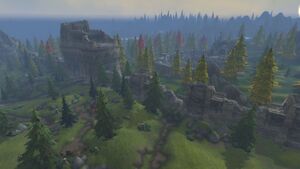
The Empire of Arathor[40][41] (or the Arathorian Empire)[42][43] was a human empire that existed millennia ago on Azeroth.[40] Its capital was the city-fortress of Strom.[42][41]
Creation
Around 2,800 BDP, in response to constant raids by the trolls, the strongest of the human tribes, the Arathi, convinced the scattered threads of humanity to gather under their rule and wove them together into the empire of Arathor. Though some tribes chafed when their destinies were bound together, the Arathi assured them the land would always belong to all peoples and named the land as a whole in homage to their ancient ancestors: Azeroth.
Together, the humans constructed the fortress city of Strom and raised an army that pushed back the trolls. Yet raids by the trolls continued to prevent any large-scale farming and remained a danger to anyone traveling outside the empire's protection. The leaders of the tribes gathered in Strom to try to conceive a strategy when word came of an elven emissary at the city gates. The stunned humans, who had long believed all the elves destroyed in the defeat of the Burning Legion, were quick to bring the envoy into their council. The envoy explained that long after the destruction wrought by the Sundering, some of the survivors had made their way to northern Azeroth and established a new kingdom, called Quel'Thalas, and a new source of magical power, called the Sunwell. She also told how the elves were waging their own war with the trolls and how the elven defenses were perilously close to falling under the onslaught. The elves requested assistance from the army of the human empire to stave off an oncoming assault that threatened to shatter the borders of the elven nation.
After discussion, Arathor agreed to help Quel'Thalas — but required that the elves teach humans the ways of magic and sorcery. The elves were quick to agree, and the combined elven and human forces drove back the trolls on both fronts until the bestial tribes held a mere shadow of their former power.[40]
Expansion
With the threat of the trolls removed, the humans spent the next centuries expanding their borders until the Empire of Arathor nearly covered the continent. As their lust for power pushed them to master the arts of magic they were learning from the elves, so did their lust for land, pulling them southward into the mountains. There, they encountered a dwarven expedition gathering supplies, and the two peoples met for the first time.[40]
The clans of Khaz Modan and the humans of Arathor met under a bright sun, and soon became close allies. The humans provided the dwarves with a wide array of surface goods, and the dwarves traded the finished goods produced in their underground workshops. Passing through the dwarven lands in peace, the humans expanded their empire into the southern half of the continent. They would also name the northern half of it with a combination of words from the human, elven, and dwarven languages: lorn, dwarven for "land"; daer, the human word for "people"; and ronae, "peaceful" in the elven tongue — hence, Lordaeron. All the races thought it was the dawn of a second great age; they would soon learn, to their sorrow, that it was already close to twilight.[44]
After beginning to use arcane magic, the humans noticed that demons were showing up on their territory, so the humans quietly went to the high elves and told them what was happening. The elves told them about how the use of arcane magic attracted the Burning Legion's attention long ago. Obviously, the Legion was still drawn to it, so the high elves explained that as long as humans continued to use arcane magic, demons would keep showing up. The humans and high elves then agreed to create the Guardian of Tirisfal to fight against the demons that were inevitably going to appear.[45]
Dissolution
As they quickly embraced the ways of magic, human mages rose in power until they matched and even surpassed their elven tutors. In parts of the empire, human sorcerers cleared fields, hunted dragons and reshaped the earth itself at their whim. To many across Arathor and to some on its ruling council, this seemed at best a too easy path and at worst an abuse of a sacred power. Confronting the wizards took the Empire of Arathor over the brink of civil war as the "magocrats" carved out their own territory where magic could be practiced without restriction. In some places, those fearful or distrustful of magic banded close to one another to prevent the mages from taking power, while others compromised and allowed the free use of magic so long as it was policed by overseers.
When all was said and done, around 1,200 BDP, the sprawling Empire of Arathor had grown too large, and civil unrest had made it to fall apart into seven separate nations: Lordaeron, Stormwind, Kul Tiras, Stromgarde, Alterac, Gilneas, and Dalaran.[46]
Notes
- ^ a b World of Warcraft: Chronicle Volume 1 describes Arathor as having first discovered the gnomes at the same time as they discovered the dwarves, in 1,200 BDP.[13] However, in The First Guardian, gnomes are shown to have already been in close contact with the humans and high elves as early as 2,600 BDP, a century before the awakening of the dwarves.
- The demonym for something from Arathor is "Arathi"[22][25] (which can also refer specifically to the Arathi tribe) or, less ambiguously, "Arathorian".[23]
- The empire is sometimes inaccurately described as having "given birth" to humanity,[47] when in fact humans as a race had existed for millennia prior to Arathor's formation.
- One of the sigils used to protect Trol'kalar in Stromgarde is named the
 [Sigil of Arathor].
[Sigil of Arathor]. - An
 [Ancient Pendant of Arathor] drops in the Trial of the Champion, and a
[Ancient Pendant of Arathor] drops in the Trial of the Champion, and a  [Relic of Arathor] formerly dropped from Lord Godfrey in Shadowfang Keep.
[Relic of Arathor] formerly dropped from Lord Godfrey in Shadowfang Keep. - Nicolas Moal in Boralus sells
 [Arathor Single Cask], a drink of immeasurable age claimed to be bottled from the only cask remaining from the empire.
[Arathor Single Cask], a drink of immeasurable age claimed to be bottled from the only cask remaining from the empire. - An area in Drustvar is named Arathor's Embrace.
References
- ^ Zidormi in the Arathi Highlands
- ^
 [Arathor Single Cask]
[Arathor Single Cask]
- ^
 [37] Sigil of Strom
[37] Sigil of Strom
- ^ a b Tides of Darkness, chapter 3
- ^ a b Ultimate Visual Guide, pg. 18: "... Dalaran was one of the city-states that made up the Arathorian Empire, the first great human civilization."
- ^ a b Blizzard Entertainment 2023-11-03. World of Warcraft®: What’s Next Panel Recap. Archived from the original on 2023-11-04.
- ^ Tides of Darkness, chapter 5
- ^
 [10-30] Sigil of Strom: "In ancient times, Lord Ignaeus of Strom, named Trollbane, led the first human civilization of Arathor in war against the trolls."
[10-30] Sigil of Strom: "In ancient times, Lord Ignaeus of Strom, named Trollbane, led the first human civilization of Arathor in war against the trolls."
- ^
 [10-30] Sigil of Thoradin: "Thoradin was the founder of Arathor. Just as I join these fragments together, he joined the scattered tribes of humans into their first great nation."
[10-30] Sigil of Thoradin: "Thoradin was the founder of Arathor. Just as I join these fragments together, he joined the scattered tribes of humans into their first great nation."
- ^ Timeline (from official site, 2004)
- ^ Timeline (from official site, 2007)
- ^ a b c d e f World of Warcraft: Chronicle Volume 1, pg. 126 - 127
- ^ a b c d e f g h World of Warcraft: Chronicle Volume 1, pg. 141 - 142
- ^ a b c d e f g
 [Arathor and the Troll Wars]
[Arathor and the Troll Wars]
- ^ a b c d e f g Saga of the Valarjar: Strom'kar, the Warbreaker
- ^

 [10-45] Weapons of Legend: "The first king of the humans, Thoradin, was a mighty ruler and a mighty warrior."
[10-45] Weapons of Legend: "The first king of the humans, Thoradin, was a mighty ruler and a mighty warrior."
- ^

 [10-45] The Sword of Kings: "The first king of the humans, Thoradin, performed many acts of heroism and valor."
[10-45] The Sword of Kings: "The first king of the humans, Thoradin, performed many acts of heroism and valor."
- ^ a b c d e f The Warcraft Encyclopedia: Anasterian Sunstrider
- ^ a b c d The Warcraft Encyclopedia: High Elves
- ^ The Troll Compendium: Early Troll Civilization - Defeat of the Amani Empire
- ^ World of Warcraft: Chronicle Volume 1, pg. 130
- ^ a b c d e f World of Warcraft: Chronicle Volume 1, pg. 130 - 131
- ^ a b c d e f
 [The Guardians of Tirisfal]
[The Guardians of Tirisfal]
- ^

 [10-45] The Sword of Kings
[10-45] The Sword of Kings
- ^ a b c d e f g h i World of Warcraft: Chronicle Volume 1, pg. 133 - 136
- ^ World of Warcraft: Chronicle Volume 2, pg. 126
- ^ The First Guardian
- ^ a b c d e f
 [The Seven Kingdoms]
[The Seven Kingdoms]
- ^
 [Legends of the Tidesages]
[Legends of the Tidesages]
- ^
 [20-60] The Ruins of Gol Var
[20-60] The Ruins of Gol Var
- ^ "Why the Mermaids Left Boralus"
- ^ Tol Barad - Game Guide: "Built by the first nation of men, the citadel of Tol Barad was once a strategic staging area for Alliance forces in the Second War."
- ^ a b Discordiankitty 2023-11-04. Wowhead's Exclusive Blizzcon 2023 Interview with Anne Stickney & Tina Wang. Wowhead. Archived from the original on 2023-11-05.
- ^ a b Arathi Basin Preview
- ^ World of Warcraft: Chronicle Volume 2, pg. 152
- ^ a b
 [The Alliance of Lordaeron]
[The Alliance of Lordaeron]
- ^ Tides of Darkness, chapter 7
- ^ World of Warcraft: Chronicle Volume 2, pg. 156 - 157
- ^ Arathi Basin - Game Guide
- ^ a b c d Lands of Conflict, pg. 18
- ^ a b Warcraft: The Roleplaying Game, pg. 24, 33
- ^ a b Lands of Conflict, pg. 89
- ^ World of Warcraft: The Roleplaying Game, pg. 33
- ^ Lands of Conflict, pg. 19
- ^ Alliance Player's Guide, pg. 133
- ^ Lands of Conflict, pg. 20, 31
- ^ Before the Storm, chapter 28, pg. 221
| |||||||||||||||||||


